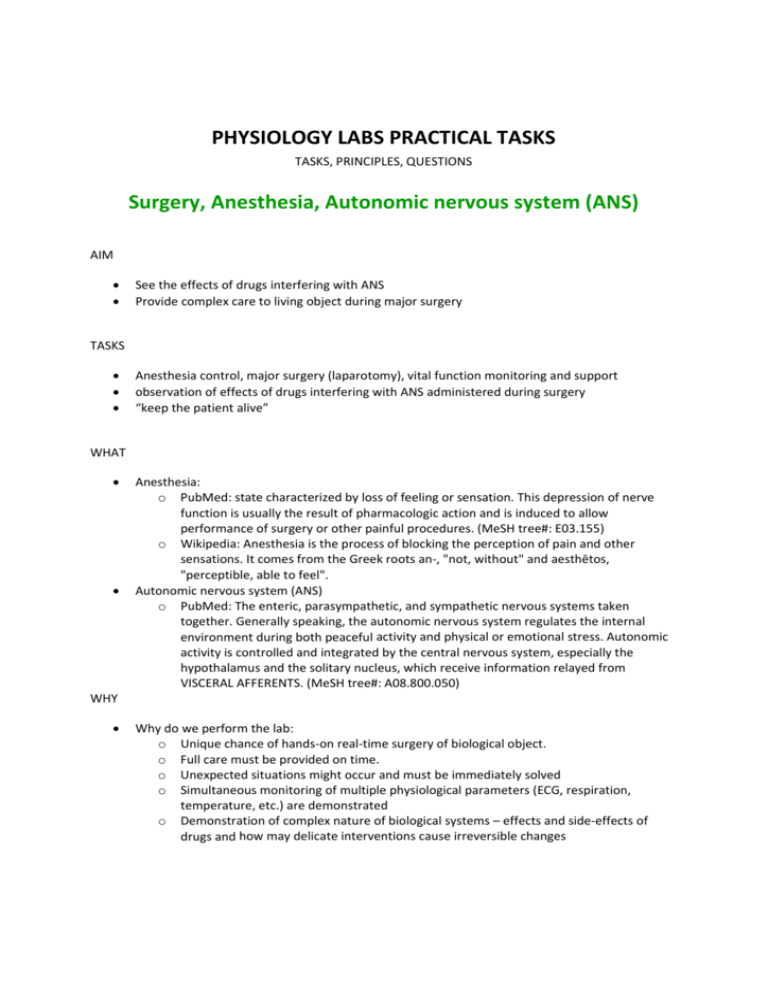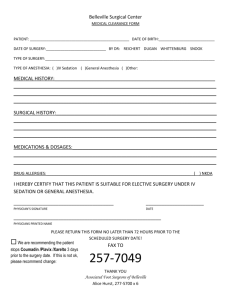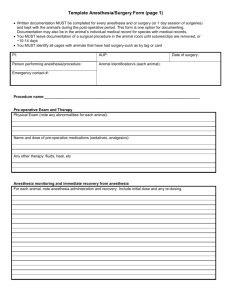PHYSIOLOGY LABS PRACTICAL TASKS Surgery, Anesthesia
advertisement

PHYSIOLOGY LABS PRACTICAL TASKS TASKS, PRINCIPLES, QUESTIONS Surgery, Anesthesia, Autonomic nervous system (ANS) AIM • • See the effects of drugs interfering with ANS Provide complex care to living object during major surgery TASKS • • • Anesthesia control, major surgery (laparotomy), vital function monitoring and support observation of effects of drugs interfering with ANS administered during surgery “keep the patient alive” WHAT • • Anesthesia: o PubMed: state characterized by loss of feeling or sensation. This depression of nerve function is usually the result of pharmacologic action and is induced to allow performance of surgery or other painful procedures. (MeSH tree#: E03.155) o Wikipedia: Anesthesia is the process of blocking the perception of pain and other sensations. It comes from the Greek roots an‐, "not, without" and aesthētos, "perceptible, able to feel". Autonomic nervous system (ANS) o PubMed: The enteric, parasympathetic, and sympathetic nervous systems taken together. Generally speaking, the autonomic nervous system regulates the internal environment during both peaceful activity and physical or emotional stress. Autonomic activity is controlled and integrated by the central nervous system, especially the hypothalamus and the solitary nucleus, which receive information relayed from VISCERAL AFFERENTS. (MeSH tree#: A08.800.050) WHY • Why do we perform the lab: o Unique chance of hands‐on real‐time surgery of biological object. o Full care must be provided on time. o Unexpected situations might occur and must be immediately solved o Simultaneous monitoring of multiple physiological parameters (ECG, respiration, temperature, etc.) are demonstrated o Demonstration of complex nature of biological systems – effects and side‐effects of drugs and how may delicate interventions cause irreversible changes HOW 1. Get ready a. See the movie (available on PCs in the labs) demonstrating the procedure b. Check the setup (ECG monitor, thermometer, respiration rate sensor, Vernier system is used as usually in our labs) c. Check the animal (already anesthetized) i. Get and record weight (mainly for drugs administration) ii. Anesthesia depth (no reaction to pain) d. Prepare the animal i. Fix to the operation table ii. perform depilation iii. connect sensors 2. Anesthesiology ‐ start monitoring, do not stop till the end of the procedure. Frequently notice: a. ECG (normal HR is cca 350‐500 bpm) b. Respiration (normal respiratory rate cca 60/min) c. Anesthesia (administer additional anesthetic if marked nociceptive reaction is observed. See #4 for dosing) d. Temperature (to prevent hypothermia and resulting arrhythmia and stress. DO NOT overheat the animal) e. Hydration (to prevent desiccation, specifically in GIT (abdominal cavity) f. Peripheral circulation (no acrocyanosis) 3. Surgery ‐ perform laparotomy (also see the movie beforehand) a. open abdominal cavity in layers (skin, fascia, musculo‐peritonemum) b. stitch the abdominal wall to the side‐mount brackets c. instill enough saline to cover intestines (otherwise desiccation and damage could result within tens of minutes) d. identify abdominal cavity organs, watch GIT motility. 4. Pharmacology a. Administer Pilocarpin ‐ parasympathetic stimulator (parasympatomimetic) i. Administer only if all vital functions are well controlled ii. Dose 0.1 mg / kg i.v. or i.p. iii. Watch all visible effects. Instantly check vital functions! b. Administer Atropin ‐ parasympathetic inhibitor (parasympatolytic) i. Timing: 1. any time if CPR is considered or started, specifically: a. in severe bradycardia b. if excessive salivation occurs c. if respiration problems occur 2. Not later then cca 15 minutes after Pilocarpin administration ii. Dose 0.01 mg / kg i.v. or i.p. iii. watch the effect (typically after few minutes) iv. Watch all visible effects. Instantly check vital functions! c. Administer Thiopental – anesthetic (barbiturate) i. Timing: 1. any time anesthesia is insufficient, e.g. a. obvious specific reactions to pain are observed (note: do not overdose – do not administer if minor nonspecific nociceptive reaction appear) b. if respiration problems occur ii. Dose 1. to prolong anesthesia 15 mg / kg i.v. or i.p. 2. to introduce anesthesia 40 mg / kg i.v. or i.p. iii. watch the effect (typically few minutes to start, lasts typically 1‐2 hours) 5. Termination of the procedure a. Remove all saline from abdominal cavity (use swabs) b. Stitch abdominal wall in layers (muscles and skin separately) c. Continue monitoring of the animal d. If vital functions are satisfactory, return the animal into the cage.








